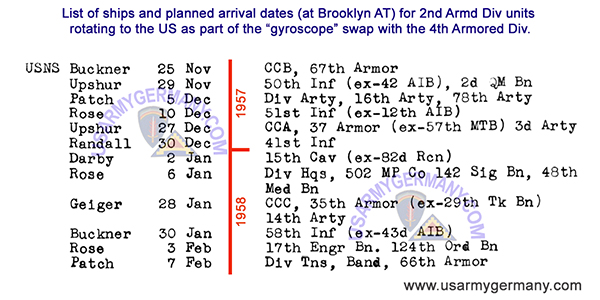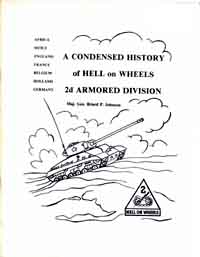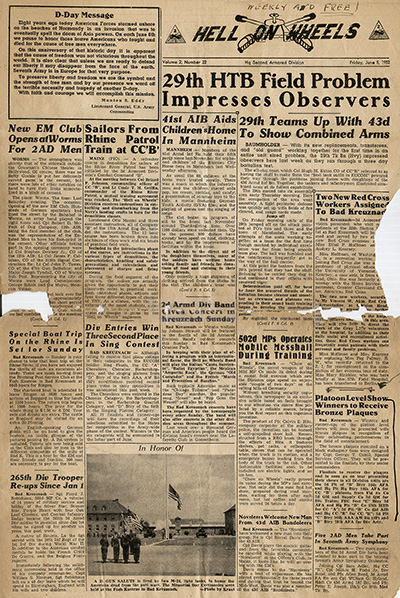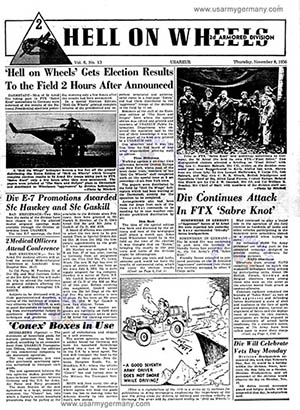| If you do NOT see the Table of Contents frame to the left of this page, then Click here to open 'USArmyGermany' frameset |
||||||||||||||||||||||||||||||||||||||||||||||||||||||||||||||||||||||||||||||||||||||||||||||||||||||||||||||||||
|
2nd Armored Division |
||||||||||||||||||||||||||||||||||||||||||||||||||||||||||||||||||||||||||||||||||||||||||||||||||||||||||||||||||
|
|
||||||||||||||||||||||||||||||||||||||||||||||||||||||||||||||||||||||||||||||||||||||||||||||||||||||||||||||||||
|
||||||||||||||||||||||||||||||||||||||||||||||||||||||||||||||||||||||||||||||||||||||||||||||||||||||||||||||||||
|
|
||||||||||||||||||||||||||||||||||||||||||||||||||||||||||||||||||||||||||||||||||||||||||||||||||||||||||||||||||
| Occupation History | ||||||||||||||||||||||||||||||||||||||||||||||||||||||||||||||||||||||||||||||||||||||||||||||||||||||||||||||||||
| (Source: A History of the Second United States Armored Division, 1940 to 1946, Lt Col E. A. Trahan, Editor. Published by Albert Love Enterprises, 1946) | ||||||||||||||||||||||||||||||||||||||||||||||||||||||||||||||||||||||||||||||||||||||||||||||||||||||||||||||||||
| A revised history of the 2nd Armd Div during the Occupation period with maps is being worked on! | ||||||||||||||||||||||||||||||||||||||||||||||||||||||||||||||||||||||||||||||||||||||||||||||||||||||||||||||||||
|
||||||||||||||||||||||||||||||||||||||||||||||||||||||||||||||||||||||||||||||||||||||||||||||||||||||||||||||||||
|
|
||||||||||||||||||||||||||||||||||||||||||||||||||||||||||||||||||||||||||||||||||||||||||||||||||||||||||||||||||
| Hell on Wheels - Some of the issues published while in Berlin | ||||||||||||||||||||||||||||||||||||||||||||||||||||||||||||||||||||||||||||||||||||||||||||||||||||||||||||||||||
|
||||||||||||||||||||||||||||||||||||||||||||||||||||||||||||||||||||||||||||||||||||||||||||||||||||||||||||||||||
| ISSUES IN COLLECTION | ||||||||||||||||||||||||||||||||||||||||||||||||||||||||||||||||||||||||||||||||||||||||||||||||||||||||||||||||||
|
||||||||||||||||||||||||||||||||||||||||||||||||||||||||||||||||||||||||||||||||||||||||||||||||||||||||||||||||||
|
|
||||||||||||||||||||||||||||||||||||||||||||||||||||||||||||||||||||||||||||||||||||||||||||||||||||||||||||||||||
| Occupation | ||||||||||||||||||||||||||||||||||||||||||||||||||||||||||||||||||||||||||||||||||||||||||||||||||||||||||||||||||
| (Source: "A Condensed History of Hell on Wheels, 2nd Armored Division", by Maj Gen Briard P. Johnson. Published by the 2nd Armored Division Association in 1980.) | ||||||||||||||||||||||||||||||||||||||||||||||||||||||||||||||||||||||||||||||||||||||||||||||||||||||||||||||||||
|
||||||||||||||||||||||||||||||||||||||||||||||||||||||||||||||||||||||||||||||||||||||||||||||||||||||||||||||||||
| Relieved by 82nd
Airborne Division, the Division started its long march to the Hanau-Bad
Orb-Schlüchtern occupational area. The Division remained
there until almost Christmas (1945), performing occupational duties,
training and athletics. Personnel shuffles were constant as groups
of veterans left for home and were replaced by new men requiring indoctrination
in Hell of Wheels traditions and standards. This paid off as morale
and discipline remained high in contrast to disturbances and clamor
in many units impatient to go home. During the last few weeks departures
were not replaced and all equipment except trucks and jeeps were turned
in. Moving in the retained trucks and at much reduced strength, the
Division left on December 20th on the three-day march to the Marseille,
France port area. Christmas was celebrated in the muddy Calais staging area. While awaiting transports all remaining equipment except individual arms were turned in and personnel were rotated between Calais and the Army rest centers along the Riviera coast. After a month waiting for transports, the remnants of the Division sailed for New York and on to Camp Kilmer, New Jersey for dispersal. |
||||||||||||||||||||||||||||||||||||||||||||||||||||||||||||||||||||||||||||||||||||||||||||||||||||||||||||||||||
|
|
||||||||||||||||||||||||||||||||||||||||||||||||||||||||||||||||||||||||||||||||||||||||||||||||||||||||||||||||||
| Cold War History | ||||||||||||||||||||||||||||||||||||||||||||||||||||||||||||||||||||||||||||||||||||||||||||||||||||||||||||||||||
 Front facade of the 2nd Armd Div HQ Building, Foch Caserne, early 1950s (BIG PICTURE video) |
||||||||||||||||||||||||||||||||||||||||||||||||||||||||||||||||||||||||||||||||||||||||||||||||||||||||||||||||||
 Main gate at Foch Caserne, Bad Kreuznach, soon after the 2nd Armored Division arrived in Germany, 1951 (James Alexander) |
||||||||||||||||||||||||||||||||||||||||||||||||||||||||||||||||||||||||||||||||||||||||||||||||||||||||||||||||||
| July 1951 - 1957 | ||||||||||||||||||||||||||||||||||||||||||||||||||||||||||||||||||||||||||||||||||||||||||||||||||||||||||||||||||
|
||||||||||||||||||||||||||||||||||||||||||||||||||||||||||||||||||||||||||||||||||||||||||||||||||||||||||||||||||
| GERMANY On arrival at Bremerhaven the Division transferred directly to troop trains for the move to Camp Y-79 near Mannheim for staging. From Y-79 units moved by truck to the various new stations. Tanks, artillery and heavy equipment were drawn from depots and other equipment unpacked. By mid-August all units had resumed training, this time in preparation for fall maneuvers and the new mission of defense of Western Europe as part of NATO forces. General Eisenhower visited the Division at its new stations shortly after training was resumed. Utilizing local training areas, small unit and crew drills, road movement and night operations were carried out concurrently with command post exercises. The September maneuver, Exercise "Jupiter," involved a crossing of the Rhine and attack from the bridgehead. Despite the short period of training between arrival and maneuver, the Division performed well. "Jupiter" was soon followed by Exercise "Combine." Part of the Division was employed across the Rhine, while CC "B" went into the field in the Mainz area to defend bridges and probable drop zones outside the city. At this time the Soviets gave indication of a possible attack with the Rhine bridges a highly probable objective. The Division was now dispersed to scattered stations as follows: |
||||||||||||||||||||||||||||||||||||||||||||||||||||||||||||||||||||||||||||||||||||||||||||||||||||||||||||||||||
|
||||||||||||||||||||||||||||||||||||||||||||||||||||||||||||||||||||||||||||||||||||||||||||||||||||||||||||||||||
| Following maneuvers
troops settled down to perfect battalion and combat command tactics
which had not been possible before leaving Fort Hood. Battalions of
CC "A", CC "B" and Div Arty rotated to Baumholder
for combat exercises and firing, for periods of three to four weeks
throughout the year. In home kasernes units conducted platoon and
company exercises and small arms training in local training areas. During the first winter all tank companies were sent, one or two at a time, for firing at the British Army tank ranges at Belsen. During the second year some units moved to the Wildflecken training area, east of the Rhine for field training. On most moves to Baumholder and other distant areas tanks and full tracked vehicles moved by rail, units becoming extremely adept in the important task of loading and detraining. Spit and polish were not overlooked. Weekly inspections of varied types and garrison parades at home stations broke the periods of field training and assured high standards of maintenance and discipline. The Division took part in several large reviews, the first marking the departure from Europe of General Eisenhower prior to his nomination for President. In the spring of 1953, the Division as part of a two-sided, four division maneuver, moved closer to the East Zone borders south of Kassel to attack toward Frankfurt. Penetrating the "enemy" rapidly and deeply into the rear areas, the rampaging 2nd Armored brought the maneuever to an early end. It had reached the peak of readiness. Parts of the Division participated in other maneuvers in Southern Germany and Austria. In another 1953 exercise, the Division reinforced by 14th Armored Cavalry Regiment and separate tank and armored infantry battalions engaged in a two-sided exercise involving a crossing of the Nahe River and attack north to secure passes through the Hunsrück Hills. One organizational action of note occurred in 1952 when the Division became fully integrated. While at Fort Hood partial integration had been affected. 29th MT Bn, 16th AFA Bn and the bridge company of 17th Engr Bn were black units. In 1952 when complete integration was ordered, all units made up packages of personnel by military specialty. Packets picked at random from black and white units and similar packets exchanged between black and white units. A uniform percentage of about 10 percent throughout the division resulted with no problems. Another personnel problem was the fact that the 12,000 men who joined the Division at Fort Hood in 1951, representing the greater part of its strength, were recruited or inducted at about the same time. To avoid a mass exodus with loss of effectiveness until new men could be trained and absorbed, many of these men were transferred over a period of several months and replaced by men having a uniform spread of expiration of services dates. Both this action and the integration were accomplished without adversely affecting combat readiness of the Division. The remaining years in Germany were as busy as the first two but, without the problems of resettlement in Germany, integration and major personnel adjustments. Maneuvers, field exercises and maintaining combat readiness and the usual home station activities, including monthly alerts, kept units on their toes. The Division had fulfilled its mission as an important element of the NATO defense of Western Europe for six years when it was returned to Fort Hood in 1957. |
||||||||||||||||||||||||||||||||||||||||||||||||||||||||||||||||||||||||||||||||||||||||||||||||||||||||||||||||||
|
|
||||||||||||||||||||||||||||||||||||||||||||||||||||||||||||||||||||||||||||||||||||||||||||||||||||||||||||||||||
| 1952 | ||||||||||||||||||||||||||||||||||||||||||||||||||||||||||||||||||||||||||||||||||||||||||||||||||||||||||||||||||
| 1953 | ||||||||||||||||||||||||||||||||||||||||||||||||||||||||||||||||||||||||||||||||||||||||||||||||||||||||||||||||||
| ORGANIZATION | ||||||||||||||||||||||||||||||||||||||||||||||||||||||||||||||||||||||||||||||||||||||||||||||||||||||||||||||||||
| (Source: STATION LIST, August 1953) | ||||||||||||||||||||||||||||||||||||||||||||||||||||||||||||||||||||||||||||||||||||||||||||||||||||||||||||||||||
|
||||||||||||||||||||||||||||||||||||||||||||||||||||||||||||||||||||||||||||||||||||||||||||||||||||||||||||||||||
| November 1957 - February 1958 (Rotation back to the U.S.) | ||||||||||||||||||||||||||||||||||||||||||||||||||||||||||||||||||||||||||||||||||||||||||||||||||||||||||||||||||
 Under the watchful eye of a senior officer, CC "B" troops embark on the USNS BUCKNER, Nov 1957 |
||||||||||||||||||||||||||||||||||||||||||||||||||||||||||||||||||||||||||||||||||||||||||||||||||||||||||||||||||
 boards the USNS BUCKNER for its trip home to Texas 1957 600.jpg) Soldiers of CC "B," part of the 1st increment, board the USNS BUCKNER, as they rotate back to the U.S. after completeing their tour in Germany, Nov 1957 (Click on the image to view a higher res version) |
||||||||||||||||||||||||||||||||||||||||||||||||||||||||||||||||||||||||||||||||||||||||||||||||||||||||||||||||||
 arrives at Brooklyn Army Terminal Nov 1957 600.jpg) The USNS BUCKNER arrives at the Brooklyn Army Terminal with the 1st increment of 2nd Armored Division, Nov 25, 1957 (Click on the image to view a higher res version) |
||||||||||||||||||||||||||||||||||||||||||||||||||||||||||||||||||||||||||||||||||||||||||||||||||||||||||||||||||
 |
||||||||||||||||||||||||||||||||||||||||||||||||||||||||||||||||||||||||||||||||||||||||||||||||||||||||||||||||||
| 12th Anniversary | ||||||||||||||||||||||||||||||||||||||||||||||||||||||||||||||||||||||||||||||||||||||||||||||||||||||||||||||||||
|
||||||||||||||||||||||||||||||||||||||||||||||||||||||||||||||||||||||||||||||||||||||||||||||||||||||||||||||||||
|
|
||||||||||||||||||||||||||||||||||||||||||||||||||||||||||||||||||||||||||||||||||||||||||||||||||||||||||||||||||
| 2nd Armored Division Troops | ||||||||||||||||||||||||||||||||||||||||||||||||||||||||||||||||||||||||||||||||||||||||||||||||||||||||||||||||||
| Hq Co, 2nd Armd Div 502nd MP Company 142nd Armd Sig Bn 520th CIC Det 82nd Recon Bn 17th Armd Engr Bn |
||||||||||||||||||||||||||||||||||||||||||||||||||||||||||||||||||||||||||||||||||||||||||||||||||||||||||||||||||
| Unit histories & additional information for the above Division Troop units will be posted as I continue my research. | ||||||||||||||||||||||||||||||||||||||||||||||||||||||||||||||||||||||||||||||||||||||||||||||||||||||||||||||||||
| Related Links: 2nd Armored "Hell on Wheels" Division - a great web site dedicated to those who served in the 2nd Armd Div from Ft. Benning in 1940 until the division was last inactivated at Ft. Hood in 1996. |
||||||||||||||||||||||||||||||||||||||||||||||||||||||||||||||||||||||||||||||||||||||||||||||||||||||||||||||||||
















